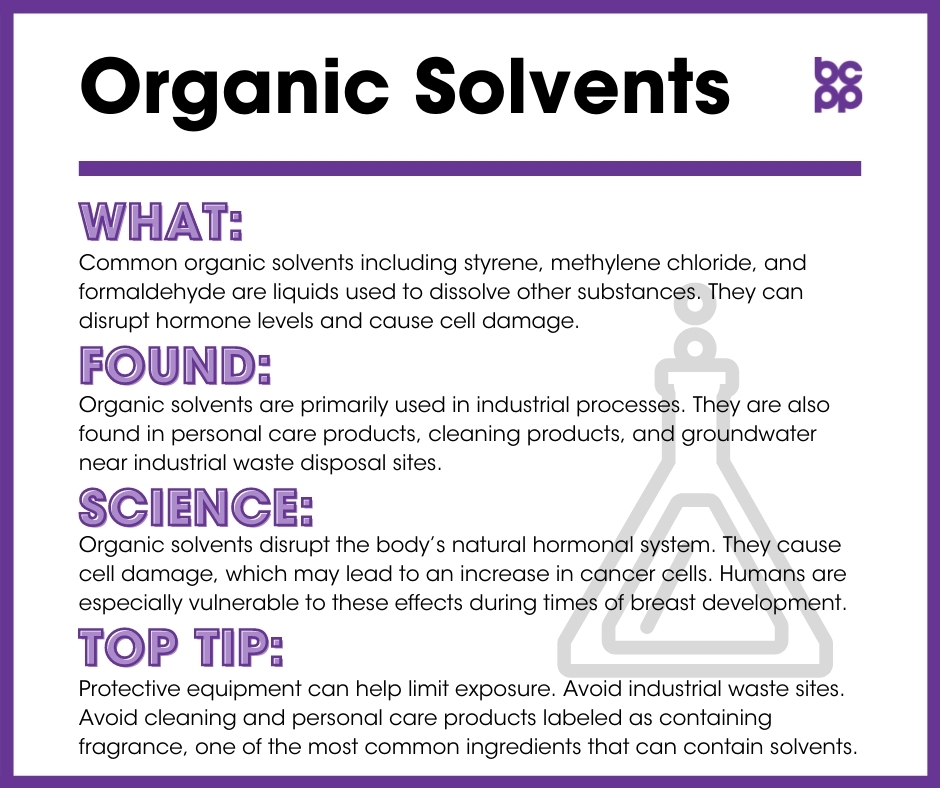Organic Solvents
What are organic solvents?
Common organic solvents including styrene, methylene chloride, and formaldehyde are liquids used to dissolve other substances.[1] They can disrupt hormone levels and cause cell damage.[2],[3] Some organic solvents easily accumulate within the fat tissue of the breast.[4],[5],[6]
Where are organic solvents found?
Organic solvents are primarily used in industrial processes including the manufacture of computer components, fabricated metal, lumber, furniture, chemicals, textiles and clothing, as well as in printing.[7] They may also be used in cosmetology, aircraft maintenance, and firefighting.[8],[9],[10],[11] Organic solvents may be found in personal care products, cleaning products, and groundwater near industrial waste disposal sites.[12],[13]
What evidence links organic solvents to breast cancer?
Organic solvents disrupt the body’s natural hormonal system.[14] They can also cause cell damage, which may lead to an increase in cancer cells. The breast tissue is especially vulnerable to these effects during times of breast development, such as during prenatal development, puberty and pregnancy.[15]
- Women exposed to high levels of carbon tetrachloride had a higher risk for breast cancer compared to women exposed to low levels.[16]
- Occupational exposure to the organic solvents styrene, carbon tetrachloride and formaldehyde resulted in an increased risk of developing breast cancer.[17]
- The organic solvent formaldehyde led to DNA damage in exposed mice.[18] Formaldehyde also promotes tumor formation and growth.[19]
- Young rats that had not undergone puberty were exposed to a mixture of organic solvents. The rats exposed to the highest concentration of solvents subsequently developed mammary tumors.[20]
Who is most likely to be exposed to organic solvents?
Employees working in industries using organic solvents are most likely to be exposed.[21],[22],[23],[24]
Who is most vulnerable to the health effects?
Age is a factor. Women who have not given birth, children who have not yet undergone puberty, and breast-fed infants whose mothers have been exposed are especially vulnerable to the toxic effects of organic solvents.[25],[26],[27],[28]
What are the top tips to avoid exposure?
The health effects of organic solvents depend on the amount of exposure; high exposure is associated with worse health outcomes. [29]
- Protective equipment such as gloves, goggles, a respirator and well-fitting protective clothing can help limit exposure.[30]
- Avoid industrial waste sites.[31]
- Avoid cleaning and personal care products labeled as containing fragrance, one of the most common ingredients that can contain solvents.[32]
- Research and talk with your employer about possible hazards and ways that exposure can be limited.[33]
Reviewed 2019
[2] Ekenga, Christine C et al. “Breast cancer risk after occupational solvent exposure: the influence of timing and setting.” Cancer Research 74, 11 (2014): 3076-83. doi:10.1158/0008-5472.CAN-13-2430.
[3] Labrèche, France P., and Mark S. Goldberg. “Exposure to organic solvents and breast cancer in women: a hypothesis.” American Journal of Industrial Medicine 32, 1 (1997): 1-14. doi:10.1002/(sici)1097-0274(199707)32:1<1::aid-ajim1>3.0.co;2-3.
[4] Wolff, M S. “Occupationally derived chemicals in breast milk.” American Journal of Industrial Medicine 4, 1-2 (1983): 259-81. doi:10.1002/ajim.1983.4.1-2.259.
[5] National Center for Biotechnology Information. “PubChem Compound Summary for CID 5943, Carbon tetrachloride.” PubChem. Accessed 6 November, 2020. https://pubchem.ncbi.nlm.nih.gov/compound/Carbon-tetrachloride.
[6] National Center for Biotechnology Information. “PubChem Compound Summary for CID 7501, Styrene.” PubChem. Accessed 6 November, 2020. https://pubchem.ncbi.nlm.nih.gov/compound/Styrene.
[7] Hansen, Johnni. “Breast cancer risk among relatively young women employed in solvent-using industries.” American Journal of Industrial Medicine 36, 1 (1999): 43-7. doi:10.1002/(sici)1097-0274(199907)36:1<43::aid-ajim6>3.0.co;2-a
[8] Spirtas, R et al. “Retrospective cohort mortality study of workers at an aircraft maintenance facility. I. Epidemiological results.” British Journal of Industrial Medicine 48, 8 (1991): 515-30. doi:10.1136/oem.48.8.515.
[9] Stewart, P A et al. “Retrospective cohort mortality study of workers at an aircraft maintenance facility. II. Exposures and their assessment.” British Journal of Industrial Medicine 48, 8 (1991): 531-7. doi:10.1136/oem.48.8.531.
[10] LeMasters, Grace K et al. “Cancer risk among firefighters: a review and meta-analysis of 32 studies.” Journal of Occupational and Environmental Medicine 48, 11 (2006): 1189-202. doi:10.1097/01.jom.0000246229.68697.90.
[11] Van Tongeren, Martie et al. Occupational cancer in Britain. British Journal of Cancer 107 (2012): S18–S26. doi:10.1038/bjc.2012.114.
[12] Environmental Working Group. “Cleaning Supplies and Your Health.” Accessed November 6, 2020. http://www.ewg.org/guides/cleaners/content/cleaners_and_health.
[13] Agency for Toxic Substances and Disease Registry. “Toxic Substances Portal: Trichloroethylene (TCE).” Last modified March 3, 2011. https://www.atsdr.cdc.gov/substances/toxsubstance.asp?toxid=30.
[14] Ekenga, Christine C et al. “Breast cancer risk after occupational solvent exposure: the influence of timing and setting.” Cancer Research 74, 11 (2014): 3076-83. doi:10.1158/0008-5472.CAN-13-2430.
[15] Kráľová, Katarína and Josef Jampílek. “Impact of Environmental Contaminants on Breast Cancer.” Ecological Chemistry and Engineering 2, 1 (2015): 9-44. doi:10.1515/eces-2015-0001.
[16] Garcia, Erika et al. “Hazardous air pollutants and breast cancer risk in California teachers: a cohort study.” Environmental Health 14, 14 (2015). doi:10.1186/1476-069X-14-14.
[17] Cantor, K P et al. “Occupational exposures and female breast cancer mortality in the United States.” Journal of Occupational and Environmental Medicine 37, 3 (1995): 336-48. doi:10.1097/00043764-199503000-00011.
[18] Speit, Günter, and Oliver Merk. “Evaluation of mutagenic effects of formaldehyde in vitro: detection of crosslinks and mutations in mouse lymphoma cells.” Mutagenesis 17, 3 (2002): 183-7. doi:10.1093/mutage/17.3.183.
[19] Yoshida, Ikuma, and Yuko Ibuki. “Formaldehyde-induced histone H3 phosphorylation via JNK and the expression of proto-oncogenes.” Mutation Research 770 (2014): 9-18. doi:10.1016/j.mrfmmm.2014.09.003.
[20] Wang, Fun-In et al. “Chronic toxicity of a mixture of chlorinated alkanes and alkenes in ICR mice.” Journal of Toxicology and Environmental Health Part A, 65, 3-4 (2002): 279-91. doi:10.1080/15287390252800864.
[21] Friesen MC, et al. “Occupational cancer.” In Women & Health, edited by MB Goldman, R Troisi, KM Rexrode, 629–645. London, UK: Elsevier, 2013.
[22] Peplonska, Beata et al. “Occupation and breast cancer risk in Polish women: a population-based case-control study.” American Journal of Industrial Medicine 50, 2 (2007): 97-111. doi:10.1002/ajim.20420.
[23] DeMatteo, Robert et al. “Chemical exposures of women workers in the plastics industry with particular reference to breast cancer and reproductive hazards.” New Solutions 22, 4 (2012): 427-48. doi:10.2190/NS.22.4.d.
[24] Delzell, Elizabeth et al. “Cancer mortality among women employed in motor vehicle manufacturing.” Journal of Occupational Medicine 36, 11 (1994): 1251-1259.
[25] The National Institute for Occupational Safety and Health. “Organic Solvent Neurotoxicity.” DHHS (NIOSH) Publication Number 87-104. Last modified June 6, 2014. https://www.cdc.gov/niosh/docs/87-104/.
[26] Ekenga, Christine C et al. “Breast cancer risk after occupational solvent exposure: the influence of timing and setting.” Cancer Research 74, 11 (2014): 3076-83. doi:10.1158/0008-5472.CAN-13-2430.
[27] Ekenga, Christine C, Christine G Parks and Dale P Sandler. “Chemical exposures in the workplace and breast cancer risk: A prospective cohort study.” International Journal of Cancer 137, 7 (2015): 1765-74. doi:10.1002/ijc.29545.
[28] Ekenga, Christine C et al. “Breast cancer risk after occupational solvent exposure: the influence of timing and setting.” Cancer Research 74, 11 (2014): 3076-83. doi:10.1158/0008-5472.CAN-13-2430.
[29] Wang, Fun-In et al. “Chronic toxicity of a mixture of chlorinated alkanes and alkenes in ICR mice.” Journal of Toxicology and Environmental Health Part A, 65, 3-4 (2002): 279-91. doi:10.1080/15287390252800864.
[30] The National Institute for Occupational Safety and Health. “Organic Solvent Neurotoxicity.” DHHS (NIOSH) Publication Number 87-104. Last modified June 6, 2014. https://www.cdc.gov/niosh/docs/87-104/.
[31] Agency for Toxic Substances and Disease Registry. “Toxic Substances Portal: Trichloroethylene (TCE).” Last modified March 3, 2011. https://www.atsdr.cdc.gov/substances/toxsubstance.asp?toxid=30.
[32] Environmental Working Group. “Cleaning Supplies and Your Health.” Accessed November 6, 2020. http://www.ewg.org/guides/cleaners/content/cleaners_and_health.
[33] ChemHAT.org. “Putting Breast Cancer Out of Work Training Materials.” Accessed November 6, 2020. www.chemhat.org/putting-breast-cancer-out-work-training-materials.






